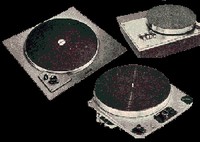Turntables 101
Author: michelle pirovich
Friday, November 8, 2002

Welcome to the History of Turntables and Turntabilism.
Make sure you take notes as next week there will be a test !
1850's - The phonoautograph is developed by French Researchers. The device records sound waves on a rotating cylinder
1870's - Thomas Edison begins to develop a tinfoil phonograph or speaking machine. The machine included a cardboard cylinder wrapped in tinfoil on a threaded axle. A mouthpiece and diaphragm were connected to a stylus that embossed the sound waves on the tinfoil. To play back the recording, a reproducer replaced the mouthpiece. To test the invention for the first time, Edison recited "Mary Had a Little Lamb" into the mouthpiece.
1876 - Elisha Gray invents the Musical Telegraph. Alexander Graham Bell beats him to the patent office and patents the technology, calling it a graphophone.
1877 - Edison unveils the first hand-cranked phonograph.
1878 - Edison patents the phonograph and intends it to be an office machine.
1887 - Bell's graphophone used wax cylinders and included a floating stylus for clearer sound. Edison improves the phonograph by using a solid wax cylinder and a battery-driven motor to replace the original hand crank.
1890 - Musicians begin recording their music. The cylinders of the phonograph had the ability to record 2-4 minutes of audio. Around 1890, musicians began to record their sessions by setting up several phonographs to record at the same time.
1892 - Flat recording discs are invented; the first of which is called the gramophone disc.
1895 - Edison begins mass production of the phonograph and continues to improve the original design by adding a large horn to amplify the sound.
1901 - The Victor Talking Machine Company of New Jersey is incorporated, and the first Victor gramophones is introduced.
1906 - A new Victor gramaphone was introduced, which featured a concealed (inside) horn. It was dubbed the Victrola.
1919 - Invention of the Theremin, by Leon Theremin (Lev Sergeivitch Termen).
The Theremin is considered the predecessor to the Moog Synthesizer. It is unique in that it is the first musical instrument that can be played without being touched.
1920's - The first electronic instruments appear. Theremin, Ondes Martenot and Trautonium
1925 - Electrical amplification (the microphone) was introduced. This invention forced engineers to re-design reproducers.
The Victor Company's answer to this revolution in sound was the Orthophonic Sound Box, which was very sensitive to high and low frequencies.
1931 - EMI researcher Alan Dower Blumlein invents stereophonic sound for recording.
1939 - Invention of the magnetic tape.
John Cage composes imaginary Landscape #1: the first piece to use electronic reproduction. The piece was performed on variable-speed turntables with RCA test tones and other sounds.
1940s - The first DJs emerge as entertainers for troops overseas.
During WWII, persons armed with a turntable, an armful of records, and a basic amplifier would entertain troops in mess halls, spinning Glen Miller, the Andrews sisters, and Benny Goodman. It was much easier than sending an entire band overseas.
1950s - Invention of the 45 RPM 7 inch records.
45 RPM records were cheaper to make and easier for American youths to carry to parties.
In Jamaica, as popularity of Jazz and R'n B increases, sound systems are used to promote the music. Sound systems developed from enterprising record shop disc jockeys with reliable American connections for 45s. They would load a pair of hefty PA speakers into a pickup truck and tour the island from hilltop to savannah, spinning the latest hits.
1951 - John Cage composes imaginary Landscape #4: the first piece to use radios as instruments.
1956 - Ska develops in Jamaica, which makes the sound system explode in popularity.
Karlheinz Stockhausen's 'Gesang der Junglinge' uses both natural sounds Tags

